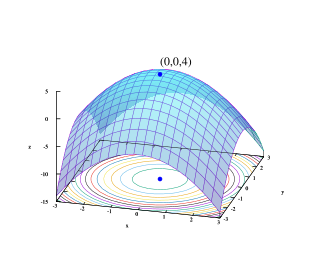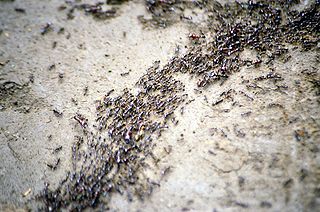Related Research Articles

In computer science, a search algorithm is an algorithm designed to solve a search problem. Search algorithms work to retrieve information stored within particular data structure, or calculated in the search space of a problem domain, with either discrete or continuous values.

The travelling salesman problem (TSP) asks the following question: "Given a list of cities and the distances between each pair of cities, what is the shortest possible route that visits each city exactly once and returns to the origin city?" It is an NP-hard problem in combinatorial optimization, important in theoretical computer science and operations research.
Heuristic routing is a system used to describe how deliveries are made when problems in a network topology arise. Heuristic is an adjective used in relation to methods of learning, discovery, or problem solving. Routing is the process of selecting paths to specific destinations. Heuristic routing is used for traffic in the telecommunications networks and transport networks of the world.

Mathematical optimization or mathematical programming is the selection of a best element, with regard to some criterion, from some set of available alternatives. It is generally divided into two subfields: discrete optimization and continuous optimization. Optimization problems arise in all quantitative disciplines from computer science and engineering to operations research and economics, and the development of solution methods has been of interest in mathematics for centuries.

A greedy algorithm is any algorithm that follows the problem-solving heuristic of making the locally optimal choice at each stage. In many problems, a greedy strategy does not produce an optimal solution, but a greedy heuristic can yield locally optimal solutions that approximate a globally optimal solution in a reasonable amount of time.
In computer science, local search is a heuristic method for solving computationally hard optimization problems. Local search can be used on problems that can be formulated as finding a solution maximizing a criterion among a number of candidate solutions. Local search algorithms move from solution to solution in the space of candidate solutions by applying local changes, until a solution deemed optimal is found or a time bound is elapsed.

In computer science and operations research, the ant colony optimization algorithm (ACO) is a probabilistic technique for solving computational problems which can be reduced to finding good paths through graphs. Artificial ants stand for multi-agent methods inspired by the behavior of real ants. The pheromone-based communication of biological ants is often the predominant paradigm used. Combinations of artificial ants and local search algorithms have become a method of choice for numerous optimization tasks involving some sort of graph, e.g., vehicle routing and internet routing.
In computer science and mathematical optimization, a metaheuristic is a higher-level procedure or heuristic designed to find, generate, tune, or select a heuristic that may provide a sufficiently good solution to an optimization problem or a machine learning problem, especially with incomplete or imperfect information or limited computation capacity. Metaheuristics sample a subset of solutions which is otherwise too large to be completely enumerated or otherwise explored. Metaheuristics may make relatively few assumptions about the optimization problem being solved and so may be usable for a variety of problems.
The greedy randomized adaptive search procedure is a metaheuristic algorithm commonly applied to combinatorial optimization problems. GRASP typically consists of iterations made up from successive constructions of a greedy randomized solution and subsequent iterative improvements of it through a local search. The greedy randomized solutions are generated by adding elements to the problem's solution set from a list of elements ranked by a greedy function according to the quality of the solution they will achieve. To obtain variability in the candidate set of greedy solutions, well-ranked candidate elements are often placed in a restricted candidate list (RCL), and chosen at random when building up the solution. This kind of greedy randomized construction method is also known as a semi-greedy heuristic, first described in Hart and Shogan (1987).
In computer science, the min-conflicts algorithm is a search algorithm or heuristic method to solve constraint satisfaction problems.

The vehicle routing problem (VRP) is a combinatorial optimization and integer programming problem which asks "What is the optimal set of routes for a fleet of vehicles to traverse in order to deliver to a given set of customers?" It generalises the travelling salesman problem (TSP). It first appeared in a paper by George Dantzig and John Ramser in 1959, in which the first algorithmic approach was written and was applied to petrol deliveries. Often, the context is that of delivering goods located at a central depot to customers who have placed orders for such goods. The objective of the VRP is to minimize the total route cost. In 1964, Clarke and Wright improved on Dantzig and Ramser's approach using an effective greedy algorithm called the savings algorithm.
Arc routing problems (ARP) are a category of general routing problems (GRP), which also includes node routing problems (NRP). The objective in ARPs and NRPs is to traverse the edges and nodes of a graph, respectively. The objective of arc routing problems involves minimizing the total distance and time, which often involves minimizing deadheading time, the time it takes to reach a destination. Arc routing problems can be applied to garbage collection, school bus route planning, package and newspaper delivery, deicing and snow removal with winter service vehicles that sprinkle salt on the road, mail delivery, network maintenance, street sweeping, police and security guard patrolling, and snow ploughing. Arc routings problems are NP hard, as opposed to route inspection problems that can be solved in polynomial-time.
In mathematical optimization and computer science, heuristic is a technique designed for problem solving more quickly when classic methods are too slow for finding an exact or approximate solution, or when classic methods fail to find any exact solution in a search space. This is achieved by trading optimality, completeness, accuracy, or precision for speed. In a way, it can be considered a shortcut.
A hyper-heuristic is a heuristic search method that seeks to automate, often by the incorporation of machine learning techniques, the process of selecting, combining, generating or adapting several simpler heuristics to efficiently solve computational search problems. One of the motivations for studying hyper-heuristics is to build systems which can handle classes of problems rather than solving just one problem.
Matheuristics are problem agnostic optimization algorithms that make use of mathematical programming (MP) techniques in order to obtain heuristic solutions. Problem-dependent elements are included only within the lower-level mathematic programming, local search or constructive components. An essential feature is the exploitation in some part of the algorithms of features derived from the mathematical model of the problems of interest, thus the definition "model-based heuristics" appearing in the title of some events of the conference series dedicated to matheuristics matheuristics web page.

Iterated Local Search (ILS) is a term in applied mathematics and computer science defining a modification of local search or hill climbing methods for solving discrete optimization problems.
Variable neighborhood search (VNS), proposed by Mladenović & Hansen in 1997, is a metaheuristic method for solving a set of combinatorial optimization and global optimization problems. It explores distant neighborhoods of the current incumbent solution, and moves from there to a new one if and only if an improvement was made. The local search method is applied repeatedly to get from solutions in the neighborhood to local optima. VNS was designed for approximating solutions of discrete and continuous optimization problems and according to these, it is aimed for solving linear program problems, integer program problems, mixed integer program problems, nonlinear program problems, etc.
The nurse scheduling problem (NSP), also called the nurse rostering problem (NRP), is the operations research problem of finding an optimal way to assign nurses to shifts, typically with a set of hard constraints which all valid solutions must follow, and a set of soft constraints which define the relative quality of valid solutions. Solutions to the nurse scheduling problem can be applied to constrained scheduling problems in other fields.
The constructive cooperative coevolutionary algorithm (also called C3) is a global optimisation algorithm in artificial intelligence based on the multi-start architecture of the greedy randomized adaptive search procedure (GRASP). It incorporates the existing cooperative coevolutionary algorithm (CC). The considered problem is decomposed into subproblems. These subproblems are optimised separately while exchanging information in order to solve the complete problem. An optimisation algorithm, usually but not necessarily an evolutionary algorithm, is embedded in C3 for optimising those subproblems. The nature of the embedded optimisation algorithm determines whether C3's behaviour is deterministic or stochastic.
A large-scale capacitated arc routing problem (LSCARP) is a variant of the capacitated arc routing problem that covers 300 or more edges to model complex arc routing problems at large scales.
References
- ↑ "Koulamas, Christos. "A new constructive heuristic for the flowshop scheduling problem." European Journal of Operational Research 105.1 (1998): 66-71".
{{cite journal}}: Cite journal requires|journal=(help) - ↑ Petch, R.J; Salhi, S. (2003). "Petch, Russel J., and Said Salhi. "A multi-phase constructive heuristic for the vehicle routing problem with multiple trips." Discrete Applied Mathematics 133.1 (2003): 69-92". Discrete Applied Mathematics. 133 (1–3): 69–92. doi:10.1016/S0166-218X(03)00434-7.
- ↑ "Bräsel, H., T. Tautenhahn, and F. Werner. "Constructive heuristic algorithms for the open shop problem." Computing 51.2 (1993): 95-110".
{{cite journal}}: Cite journal requires|journal=(help)